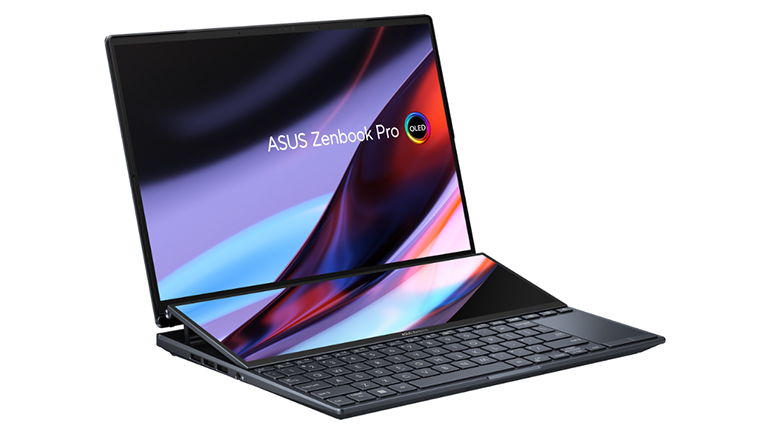
































Zenbook Pro Duo laptops from Asus have a main screen and a secondary display that sits above the keyboard. I've reviewed the 15-inch ZenBook Pro Duo 15 OLED, and now it's the turn of the smallest member of the family, the Zenbook Pro 14 Duo OLED.
When the Zenbook Pro 14 Duo OLED closed it looks like a regular 14.5-inch laptop -albeit one that's on the thick and heavy side. It measures 32.35cm wide by 22.47 deep by 1.79cm thick at the front, rising to 1.96cm thick at the back. The weight of 1.7kg is a fair bit for a laptop of this size, which relates largely to the second screen. MIL-STD-810H certification should take care of any concerns about potential damage from knocks and bangs in transit.
Asus Zenbook Pro 14 Duo OLED (UX8402): 12th-generation H-series Intel Core i7 or i9 processors, integrated or discrete (Nvidia) graphics, up to 32GB of RAM and 2TB of SSD storage. The main screen is a 14.5-inch OLED, while the secondary screen is a 12.7-inch IPS panel (both are touch-responsive).
Image: Sandra Vogel /It's only when you open it up that this laptop's key differences -the secondary screen and unique keyboard area setup -become apparent. The main screen is also noteworthy: a 16:10 OLED touch display with 2.8K (2,880 x 1,800) resolution that's bright (550 nits) and benefits from a 120Hz refresh rate.
Creative users working on graphics-heavy projects will appreciate the display's faster refresh rate and OLED technology, which delivers sharp and vivid colours and offers wide viewing angles.
The screen sits in small bezels all around, which Asus says deliver a 93% screen-to-body ratio. Shallow bezels make viewing more enjoyable, as well as helping to keep the overall footprint of the laptop as small as possible. There is for a webcam above the screen -720p with IR for Windows Hello face authentication in our case, although 1080p is also available according to the Asus spec sheet.
Asus bundles its Asus Pen 2.0 stylus and a short charge cable. The stylus can be used with both the main and secondary screens. Unfortunately there's no housing for the stylus on the laptop, and no magnetic system for keeping it attached to an edge of the device.
The secondary ScreenPad Plus is a 12.7-inch IPS panel with 2,880-by-864 resolution. It matches the width of the main screen and is 3.75 inches tall. When the laptop lid is lifted, the ScreenPad Plus raises at its back, so that it sits at an angle. This makes it easier to view and also provides space for heat dissipation, but you can't alter the angle of the secondary screen.
As with previous ZenBook Pro Duo laptops, the secondary screen has multiple functions. Asus is now at version 3 of its ScreenPad Plus software, and this delivers new use cases. These include using the extra 3.75 inches of depth to extend the height of content on the main screen and setting up application groups that all launch at one tap of their group icon. You can run apps independently on the second screen, including by dragging them from the main screen. It's also possible to run two or three apps independently on the second screen, obviously in small app windows. Creators can also use the second screen for specialist touch controls developed for Adobe Photoshop, Lightroom Classic, Premiere Pro, and After Effects.
The portrait-mode touchpad takes some getting used to.
Image: Sandra Vogel /These features work quite well, but the ScreenPad Plus has two important consequences for the keyboard and touchpad, and if these will be used as the primary input systems, then potential users may want to try before they buy.
First, there's no wrist rest. This means your wrists either dangle in mid-air or sit very awkwardly on a desk -- unless you acquire a separate wrist rest. I found the first two options uncomfortable and unsustainable long term. Still, the keyboard is made up of large and well-spaced keys that have a bouncy and responsive action. Once I had found an old wrist rest lurking in a drawer, I was typing at normal speed with no problem, although there was still a persistent off-centre feeling thanks to the relocation of the touchpad.
The portrait-mode touchpad's location to the right of the keyboard is unsuitable for navigating a landscape-mode screen, although I eventually became used to it. It's also very small, so that the mousing area felt very confined, even after I had adjusted to the orientation.
The speakers are pretty good. Sound quality is above average, maximum volume is quite high, and there's no distortion at top volume. I was happy listening to rock and classical music, as well as spoken-word podcasts.
There is no compromise on specifications, with 12th generation Intel H-series Core i7 and Core i9 processors on offer, along with up to 1TB of storage, up to 32GB of RAM, and either integrated Intel Iris Xe graphics or discrete Nvidia GeForce RTX 3050 Ti graphics.
The top-end
 Hot Tags :
Tech
Our process
Computing
Laptops
Hot Tags :
Tech
Our process
Computing
Laptops